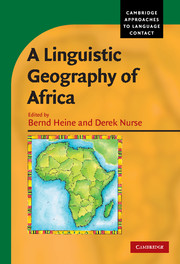Book contents
- Frontmatter
- Contents
- List of maps
- List of figures
- List of tables
- List of contributors
- Series editor's foreword
- Acknowledgments
- Abbreviations
- 1 Introduction
- 2 Is Africa a linguistic area?
- 3 Africa as a phonological area
- 4 Africa as a morphosyntactic area
- 5 The Macro-Sudan belt: towards identifying a linguistic area in northern sub-Saharan Africa
- 6 The Tanzanian Rift Valley area
- 7 Ethiopia
- 8 The marked-nominative languages of eastern Africa
- 9 Africa's verb-final languages
- Notes
- References
- Index
8 - The marked-nominative languages of eastern Africa
Published online by Cambridge University Press: 22 September 2009
- Frontmatter
- Contents
- List of maps
- List of figures
- List of tables
- List of contributors
- Series editor's foreword
- Acknowledgments
- Abbreviations
- 1 Introduction
- 2 Is Africa a linguistic area?
- 3 Africa as a phonological area
- 4 Africa as a morphosyntactic area
- 5 The Macro-Sudan belt: towards identifying a linguistic area in northern sub-Saharan Africa
- 6 The Tanzanian Rift Valley area
- 7 Ethiopia
- 8 The marked-nominative languages of eastern Africa
- 9 Africa's verb-final languages
- Notes
- References
- Index
Summary
Africa is a continent where grammaticalized case systems are a rare phenomenon. Of the roughly 2,000 languages there are only a few with grammaticalized case, probably less than one-tenth of all African languages. Of the two basic case systems, (nominative/)accusative and ergative(/absolutive) distinguished worldwide, the latter hardly occurs in Africa, and the former accounts for less than one-third of all African case languages. The majority of African case languages, that is, roughly two-thirds, belong to the so-called marked-nominative type. Elsewhere in the world, marked-nominative systems are virtually non-existent.
African case languages show an areal and genetical distribution: Afroasiatic and Nilo-Saharan are primarily the phyla with case languages. Eastern Africa is a region with a high concentration of case languages in general and of marked-nominative languages in particular. In the border region of Uganda, Kenya, Ethiopia, and Sudan, marked-nominative languages are nearly the only type of case-marking languages to be found. Neighboring marked-nominative languages may belong to different phyla, namely Afroasiatic or Nilo-Saharan. In this chapter it is argued that marked-nominative systems are at least to some extent an areal phenomenon.
Introduction
Marked-nominative case systems stand out against other types of case systems, their defining property being that in such systems the nominative case is functionally marked vis-à-vis the accusative case (see section 8.2.1 for more details).
In the relevant literature, the phenomenon of marked-nominative languages has been recognized mostly from the perspective of each regional philology: Cushitists, Berberologists, and Niloticists all have looked at the phenomenon within their own language subgroup.
- Type
- Chapter
- Information
- A Linguistic Geography of Africa , pp. 251 - 271Publisher: Cambridge University PressPrint publication year: 2007
- 4
- Cited by



